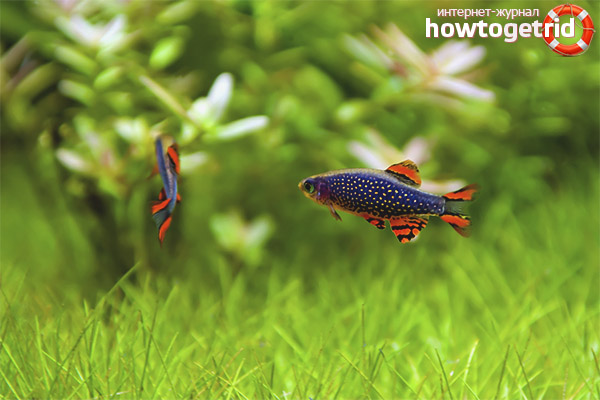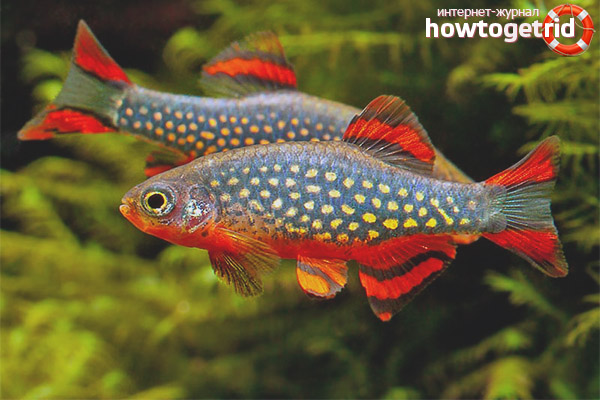The content of the article
Microparsing is a fairly popular and beautiful fish. Its sensational appearance in the world of aquarium animals lovers occurred relatively recently. The incredible excitement was caused by the fact that such a variety of fish did not appear in the aquarium area for a rather long time. That is why a large number of specialists initially suggested that they have photoshop in front of them, and not pictures of a real fish.
In fact, the discovery of the galaxy’s microassortment occurred literally a couple of weeks before the first reports of it in the public. It was discovered in one of the small ponds of East Asia in Burma. The region where this fish was discovered for the first time was rarely visited by Europeans, and therefore it is not surprising that it and several other species were discovered by aquarium fish lovers so late. Despite the fact that several more species of fish were discovered along with microparsing, it was this species that was able to overshadow all the others with its appearance, since it is very special and original.
The new species of fish was given the name of the microparsing galaxy, but later on the Latin nickname was replaced by another name - Danio margaritatus. This is justified by the fact that at first it was rather difficult for scientists to attribute this fish to any particular variety or subspecies.
Fish Description
Males are distinguished by a gray-blue coloring of their body, on which distinct small pearl spots are scattered. The fins have red and black stripes, while the edges of the fins remain transparent. Also, the male of these fish has a characteristic bright red abdomen.
In females, the body color is more modest, spots are also not so distinct and bright, red fins are paler and more likely close to an orange hue.
Natural fish habitat
The depth of such lakes is scanty, and does not exceed thirty centimeters, the water is notable for its purity, and blix and eledea are considered the preferred varieties of vegetation. Thanks to the evolutionary development of microsorting, she managed to adapt to the environment to the maximum, which must be remembered by all aquarists who plan to get this kind of fish for themselves. There is no specific information regarding the parameters of water that is recommended to be used to keep this fish in the aquarium. The only thing that is known is that the main criterion is the softness of the water and the neutral salt-base balance.
Keeping fish in aquarium conditions
If we take into account the maximum size that a galaxy can make micro-analysis, then among officially registered parameters it reaches 21 millimeters. To keep this fish, a shrimp or nano-aquarium is best suited. However, these individuals have a relatively short life cycle, which does not exceed two years. If aquariums with sufficiently large volumes are selected for maintenance, it is possible to track a very interesting line of behavior for these fish living in a large school. Shelter is not provided to pack leaders, not dominant males. The best option for keeping a school of this fish species is a stock of at least twenty individuals.
In order to create conditions as close as possible to the natural environment for the micro-analysis of the galaxy, the aquarium must be densely planted with aquarium plants. With an insufficiently planted aquarium or in the absence of vegetation in it, the microparsing will become rather shy, the color will turn pale, and almost all the time the fish will be in shelter.
When the owner of the aquarium purposefully intends to engage in breeding microassortments, he needs to know one important point: these fish are not recommended for the resettlement of any neighbors, they do not get along with shrimps and snails. This is justified by the fact that these fish are not too hospitable and rather timid, and therefore, if strangers are present on their territory, they are unlikely to spawn normally. If you just plan to keep the fish, without the prospect of further breeding, then as neighbors you can choose different varieties of the same small fish, which will be either the same size or slightly smaller. A good neighborhood in microparsing is obtained, for example, with cardinals, wedge-shaped parsings or neons.
Selection of feed for microparsing
Almost all species of fish that belong to this species are omnivorous, including the galaxy. In the natural habitat, these fish preferably consume insects, algae and zooplankton. As for aquarium microsorting, they feed on almost all artificial feeds, with the exception of cereals. If the diet of this fish is quite diverse, it will behave very actively, there will be no health problems, and its appearance will please any observer. This fish can eat any frozen or live food, for example, brine shrimp, tubule maker, bloodworms or coronet. However, it should be borne in mind that these individuals have rather small mouths, and therefore the size of the feed should not be too large so that the pets can eat without problems.
When the micro-sorrows go through the period of adaptation and are in a rather alarming state due to getting into a new aquarium, small live feeds should be selected for their feeding, and only after the fish is fully used to the environment can an artificial feed be introduced.
Galaxy compatibility with other fish

If we consider the compatibility of the microsorbing of the galaxy and other species of fish, it is worth noting that these fish are not distinguished by hospitality and friendliness, and therefore it is better to keep them isolated. The galaxy is a rather small fish, and therefore small or nano-aquariums, which do not provide for the presence of any other fish other than this species, are perfectly suitable for its maintenance. When, nevertheless, it is planned to settle several types of fish in one aquarium, along with the galaxy microsort, the calm and small fish, which will not be larger than the galaxy, will become the most suitable neighbors.
The only minus of the galaxy is that, while living in a flock, some individuals can behave quite atypically, even despite the fact that, living in a large group, these fish behave less aggressively than a few pieces. Although this variety of scorpion prefers to stay in certain groups, it is not a flock of fish. Males prefer to devote all their time to courtship of females and fight with emerging rivals.
Gender differences
Females, in contrast to males, are faded. And therefore, against the background of males, they are very different in appearance. Thanks to this distinguishing feature, to distinguish where the female is and where the male, at first glance is not difficult. Females have a blue-green body color and inexpressive cream spots. Their fins are also quite pale and close to an orange hue.
Breeding microparsing
The microparsing galaxy belongs to the family of cyprinids; therefore, it propagates by throwing eggs. For this fish, caring for its offspring is not peculiar. With good feeding and densely planted vegetation in the aquarium, fish can spawn on their own, without the help of the owner. But, if it is planned to withdraw the maximum number of fry, it is necessary to take specific measures and use a separate spawning ground. It is possible to breed micro-analysis even in a small-sized aquarium, approximately 10-15 liters, however, water must be taken from the main aquarium. The bottom of the spawning aquarium should be lined with a protective net, nylon threads or small-leaved plants, like Javanese moss. This measure is used to prevent the galaxy from eating its offspring.
Video: aquarium fish microparsing galaxy










Submit